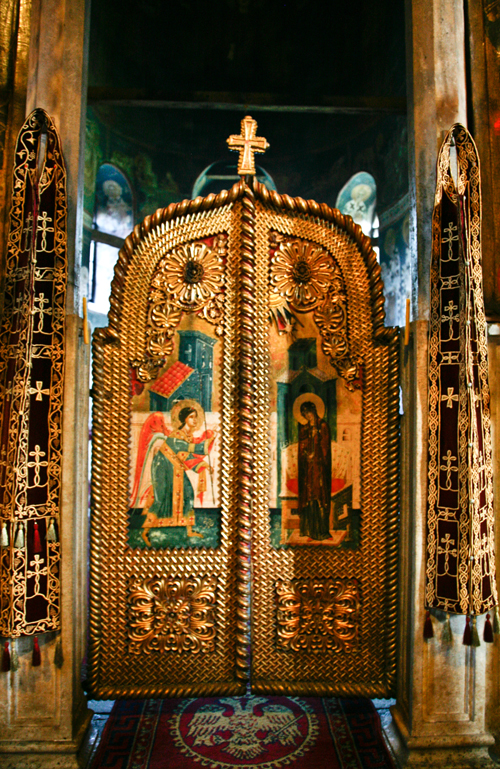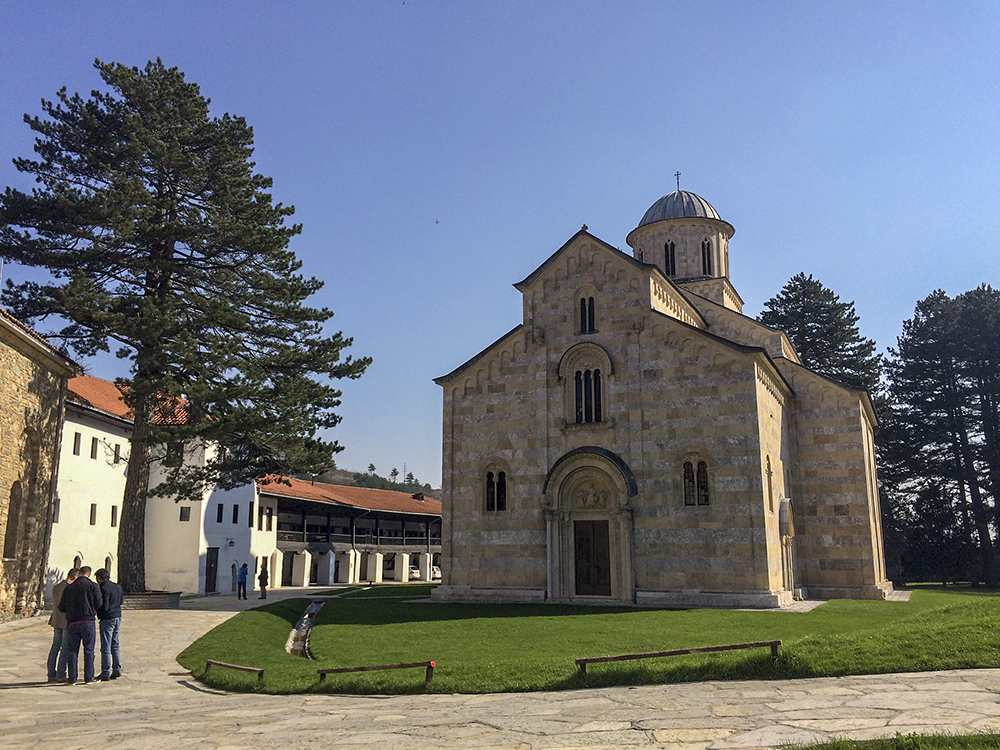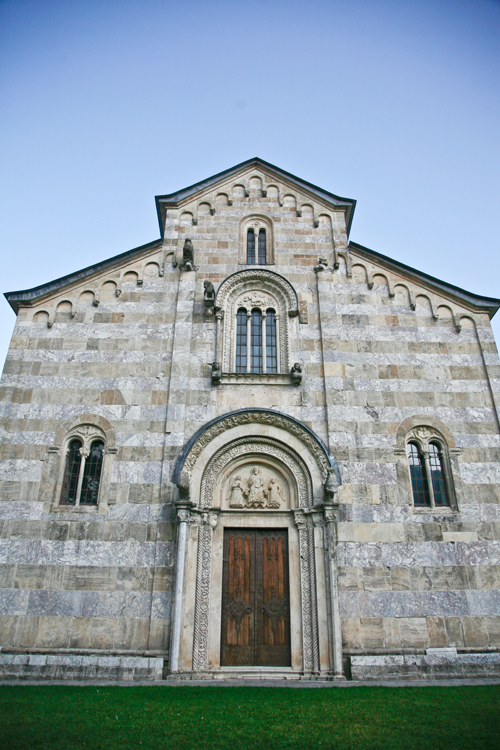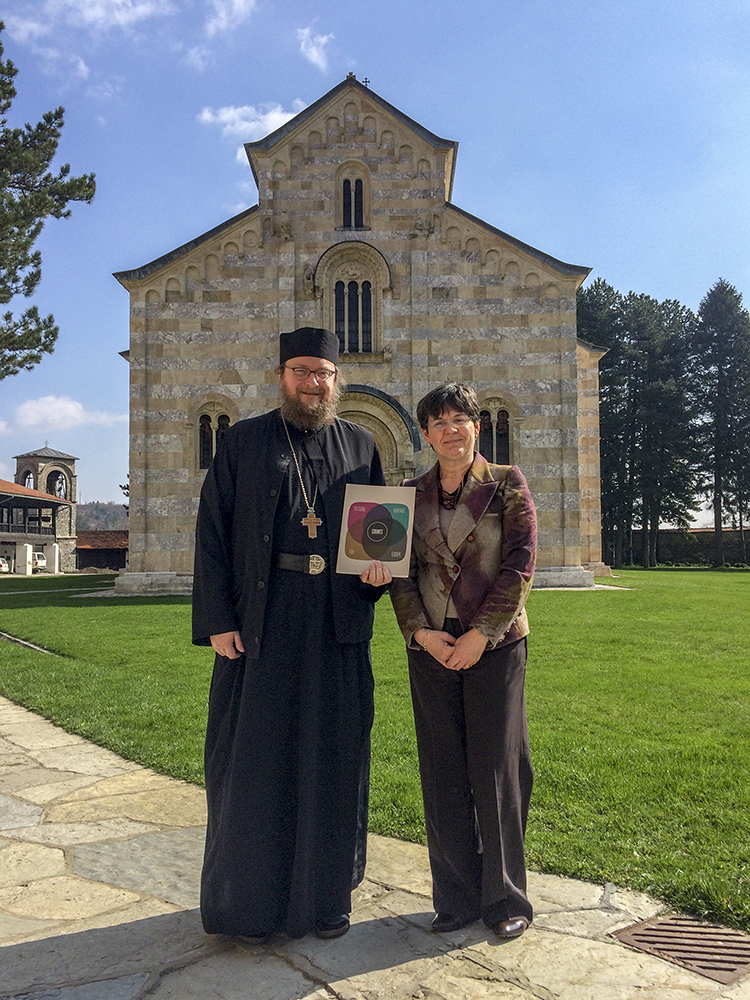Nestled in a forested valley in the foothills of the Accursed Mountains National Park is a 14th century Serbian Orthodox Church compound — the Visoki Dečani Monastery.
Though seven centuries old, the structures and grounds of the compound are lovingly maintained, so trim and picturesque as to seem contemporary. And when the resident monks aren’t busy with their liturgical duties, they’re likely to be feeding the geese or tending the orchards on the many acres of active farmland.
Behind the walls of the monastery a feeling of calm and contemplation prevails. But outside, in the realm of public discourse, the monastery is at the center of contentious debate.
Since the end of the war in 1999, NATO soldiers have been guarding the monastery as a high profile deterrent against the types of attacks that many other Serb cultural and religious sites in Kosovo faced between 1999 and 2004. At the same time, the monastery has been in drawn out legal battles with Kosovo’s state institutions for the last 20 years over land usage rights.
These were the factors cited in April by the cultural preservation organization Europa Nostra when they declared the Dečani Monastery one of 2021’s “7 Most Endangered Heritage Sites in Europe.”
The designation sparked outrage and a flurry of letters of protest by Kosovo’s government representatives as well as a letter from a collection of 40 Kosovo-based NGOs. The letters argued that the designation gives an unrealistic portrayal of the situation in Kosovo, one that undermines the country’s international standing.
Most concerning were a number of questionable claims about Dečani included in Europa Nostra’s December 2020 shortlist announcement, claims that suggested the information-gathering process underpinning the nomination may have been one-sided. Some of these claims were remarkably similar to Serbian government talking points or to some of the more alarming statements from the Serbian Orthodox Church concerning the security of their holy sites in Kosovo.

The Visoki Dečani Monastery in the foothills of the Accursed Mountain National Park has been at the center of a fierce debate about whether it is really under threat after being listed as one of Europe’s “most endangered” cultural heritage sites. Photo: Courtesy of Dečani Monastery / CC2.0 (adapted).
For all their concern of a realistic portrayal of the situation, the letters from Kosovo’s government representatives and the NGOs largely ignored the specific threats to the monastery’s legal rights and security that Europa Nostra cites in the April announcement. Meanwhile, the Serbian government and the Serbian Eparchy of Raška-Prizren, the Serbian Orthodox diocese for Kosovo, celebrated the news from Europa Nostra, responding with their own public statements that contain dire claims of imminent threat.
In a statement posted in June, Europa Nostra emphasized that the Dečani Monastery “should serve as a valuable link between all citizens who are … dedicated to restoring dialogue and peace between various communities.” But so far the designation on the Most Endangered list seems only to have heightened disagreement.
With all parties talking past each other, K2.0 breaks down the various arguments and controversies surrounding the designation of the Dečani Monastery as one of the “7 Most Endangered Heritage Sites in Europe.”
What is Europa Nostra and what is their Most Endangered program?
Europa Nostra is an almost 6o-year-old cultural heritage organization that serves as a central node for local preservation organizations across Europe. It is based out of Brussels, Belgium and The Hague, Netherlands. Since 2002 they have run the “European Union Prize for Cultural Heritage/Europa Nostra Awards,” which celebrates successful cultural heritage conservation.
In 2013 they began the roughly biannual “7 Most Endangered” program, which identifies endangered heritage sites across Europe. The stated goal is to help mobilize local and international efforts for preservation or restoration of the endangered sites.
Of the 43 endangered sites they’ve designated over six cycles, the most common threats relate to disrepair, poor maintenance, or planned demolition. Occasionally the list is used to marshal opposition to development that Europa Nostra deems unfitting.
“We have never had a similar reaction, or should I say overreaction in terms of public statements.”
Guy Clausse, Europa Nostra executive vice-president
While Europa Nostra’s selection of Dečani has caused an uproar, their choices are usually uncontroversial. Among the selections for the 2021 list are a 130-year-old tourist train in the Austrian Alps whose operator went bankrupt and an aristocratic pleasure garden in Verona, Italy that was damaged by severe thunderstorms.
In an interview with K2.0, Europa Nostra’s executive vice-president Guy Clausse said that the angry response in Kosovo has been unprecedented in the program’s history. “In those 43 cases we have never had a similar reaction, or should I say overreaction in terms of public statements,” he said.
Alongside Dečani, the 2021 list includes three other sites in southeast Europe as among the seven most endangered sites in Europe: a Zagreb cemetery structure suffering from earthquake damage, a Yugoslav-era brutalist building in Skopje that was never properly restored following fire damage, and a number of Greek islands whose views Europa Nostra is trying to protect from the sight of wind farms.
The list is compiled each cycle by soliciting nominations from member organizations. The nomination of Dečani came from a Brussels-based organization called Future for Religious Heritage.
How is the Dečani Monastery said to be endangered?
In their official announcement in April, Europa Nostra listed three main justifications for the monastery’s inclusion on the list.
The first is the fact that the monastery has been continuously guarded by NATO troops since 1999, and, for related reasons, has been inscribed on the UNESCO List of World Heritage in Danger since 2006.
Another listed threat is a road development project connecting the municipality of Deçan with the town of Plav, Montenegro. Ahead of the nomination, a portion of the road was being built through a special Protected Zone surrounding the monastery, and would have passed by the gates. Europa Nostra asserted that not only would the road upset the calm natural setting of the monastery, its construction in that zone wasn’t legally permissible. Though the road project was suspended in summer 2020 in agreement with local authorities, Europa Nostra calls for close monitoring of the situation.
Finally, the text cites a legal case brought by the monastery to confirm ownership of 24 hectares of disputed land. Though Kosovo’s Constitutional Court decided in Visoki Dečani’s favor in 2016, the local municipality has refused to officially register the land to the monastery for the last five years, leaving the issue in limbo.
So this means the monastery is in fact endangered?
Taken at face value, yes, but there are extenuating circumstances related to each of these issues that go unmentioned by Europa Nostra. To understand the controversy, each of these threats needs to be unpacked and contextualized.
Let’s start with the NATO soldiers that are stationed at Dečani — why are they there?
For many Serbian commentators, the continued presence of KFOR — NATO’s deployment in Kosovo — at Dečani is evidence enough alone that the monastery remains in the same serious danger it has been in since 1999.
In the months following the arrival of NATO peacekeeping forces in Kosovo in 1999, Serb cultural and religious sites faced frequent revenge attacks from Albanians who had endured a decade of repression — culminating in orchestrated mass atrocities — at the hands of Slobodan Milošević’s regime. Alongside cultural heritage sites, everything from village Orthodox cemeteries to Serb residencies were targeted, and NATO and UNMIK had a poor record of protecting these sites.
Later, in March 2004, a large-scale two-day anti-Serb riot broke out across Kosovo following unsubstantiated media reports that the drowning of three young Albanian boys was a result of having been chased into the Ibar River by a group of Serbs. Many significant Serb holy sites that avoided destruction in 1999 were damaged or destroyed in the riots and an angry crowd gathered to march on the Dečani Monastery. Though KFOR was unprepared and overwhelmed by the crowds throughout most of the country, they managed to keep the mob away from the monastery.

The interior of the Dečani Monastery is ornamentally decorated and contains icons that are hundreds of years old. Photo: Atdhe Mulla / K2.0.
It was partly in response to the 2004 riots that the “Medieval Monuments in Kosovo” — which includes Dečani — were inscribed on the UNESCO List of World Heritage in Danger in 2006. The Medieval Monuments also include the Gračanica Monastery, Our Lady of Ljeviš Church in Prizren, and the Patriarchal Monastery of Peć. Our Lady of Ljeviš was seriously damaged in the 2004 unrest and has since been partially restored. The others escaped the riots without damage.
A recent public statement from the Eparchy of Raška-Prizren about the Most Endangered list makes much of KFOR’s presence as well as the destruction of 1999 and 2004. They also cite attempted grenade attacks targeting the Dečani Monastery in 2000 — in the immediate aftermath of the war — and in 2007. Kosovo Police arrested the perpetrator of the 2007 attack and he was subsequently sentenced to three and a half years in prison.
All these examples make a convincing case that the monastery was under serious physical danger in the particular context of the early 2000s and that international military protection was necessary. It is less certain whether that level of protection still makes sense today.
Is the monastery still facing security threats today?
Since Kosovo’s independence in 2008, there have been two security incidents at the Dečani Monastery.
In 2014 resident monks reported threatening graffiti written on the monastery’s exterior walls and surrounding agricultural outbuildings on two occasions. The perpetrators are not known.
In early 2016, four men in a car were arrested by Kosovo Police after approaching the monastery. Though media coverage is spotty, it appears two guns were found on the men, and prosecutors claimed that one of the men had previously fought in Syria. It was also reported, based on unnamed sources, that police had found an ISIS flag in the home of one of the men.
The Serbian media was soon filled with claims that “armed jihadists tried to attack Visoki Dečani,” a narrative that the monastery continues to promote.
The men claimed they were simply heading into the hills above the monastery to camp. They were charged with illegal possession of firearms and sentenced to 30 days detention. To the frustration of the monastery, no terrorism-related claims were pursued.
Though it is unclear whether a potential attack was in the works or not, media reports stated that the car had been followed to the monastery by Kosovo Police and apprehended without major incident, indicating a degree of seriousness and capability of the police force to protect the monastery.

After signing in with security forces outside, visitors are free to wander around the monastery complex. Photo: Europa Nostra / CC2.0.
KFOR maintains intense security protocols at the monastery. Approaching cars are forced to weave slowly through barricades and visitors must show identification and sign in with NATO soldiers who are stationed at the gates and patrol the exterior. On some days there are almost as many soldiers milling about the central courtyard as there are monks.
However, according to a recent article in Prishtina Insight by cultural heritage professional Nora Weller, there have been ongoing negotiations to hand over protective duties at Dečani from KFOR to Kosovo Police, and a similar claim was made recently by Serb citizens in local media reports.
The other three Serbian Orthodox monuments in Kosovo on UNESCO’s list of World Heritage in Danger are already protected by Kosovo Police, rather than KFOR.
The 13th century Patriarchate of Peć — less than 20 kilometers from Visoki Dečani in the city of Peja and an even more religiously and historically significant site for Orthodox Serbs — has been under the protection of the Kosovo Police since 2013 without notable incident.
Were the Medieval Monuments in Kosovo completely secure, prudence wouldn’t demand police protection at all. However, highlighting the international military protection at Dečani can lead one to overestimate the degree of danger the monastery finds itself in.
OK, what’s up with this road project?
Since 2014 a road has been planned to connect Deçan municipality over the mountains to Plav, Montenegro. The most direct route is through the monastery’s land.
The initial plan was to build a bypass road around the Dečani Monastery’s special Protected Zone, the area where there are legal restrictions on development.
However, in 2018 — during the premiership of Deçan native Ramush Haradinaj, whose AAK party leads the local Municipality — road crews began widening a narrow dirt road that passes through the Protected Zone. It became clear the Municipality was trying to build the road directly past the monastery, bypassing the bypass. The Serbian Orthodox Church and the monks at Dečani protested that the proposed international road would destroy the calm environment of the monastery, and that the project was a blatant violation of the law.
Significant international pressure was exerted to suspend the road work, and a rotating group of foreign ambassadors visited Dečani to draw attention to the violation and demand a halt. Despite this, it took until late summer 2020 for the project to be suspended, largely due to international pressure. Throughout summer 2020, then Prime Minister Avdullah Hoti, former PM Ramush Haradinaj and Deçan’s mayor Bashkim Ramosaj were all pushing hard for the acceleration of the road works.
These claims ring hollow for the monastery given the length of time and extent of international pressure necessary to halt an openly illegal road project.
In March, President Vjosa Osmani and Prime Minister Albin Kurti addressed a letter to Europa Nostra in which they state that “there is no evidence implicating any local or central institution of the Republic of Kosovo in discriminatory practices against the Monastery of Deçan,” and that, “the Municipality of Deçan … has committed to treat the special area of the Monastery of Deçan with special priority and a high level of seriousness.”
These claims ring hollow for the monastery given the length of time and extent of international pressure necessary to halt an openly illegal road project.
Further, the monastery expects little of the Municipality of Deçan, given that the mayor has previously implied he thinks the abbot is “crazy,” demanded the road be built through the special Protected Zone or he would “do it himself,” and claimed, without evidence, that the monastery had faked security incidents in the past to gain attention.
In April, Minister for Culture, Youth and Sport Hajrullah Çeku addressed a letter to Europa Nostra in which he dismissed the monastery’s concerns, stating, “the only alleged concern regarding the Decani Monastery is said to be an unbuilt road for which Europa Nostra itself finds that an agreement has been reached between all parties, including the Orthodox clergy.”
While Çeku cites the suspension of the road development as a sign that the current system incorporates the concerns and needs of the monastery, it isn’t just the local firebrands Haradinaj and Ramosaj who have been pushing for a continuation of the project. The new government’s Minister of Environment, Spatial Planning and Infrastructure, Liburn Aliu, has also stated his desire to build the road in the monastery’s special Protected Zone.
Çeku’s letter to Europa Nostra also stated that “The Republic of Kosovo is the highest instance of protection of cultural heritage assets in the country. We protect our heritage.” This is a rather different claim than the one Çeku made to Prishtina Insight in 2015, before he was a government minister, when he complained that there was widespread abuse and neglect of cultural sites in Kosovo, both Albanian and Serbian.

Much of the recent debate about the Dečani Monastery has involved all sides talking past each other, rather than genuinely engaging with the other side of the argument. Photo: Atdhe Mulla / K2.0.
But what are these special Protected Zones?
Special Protected Zones are a provision of the 2007 Ahtisaari Plan, the document that forms the basis of Kosovo’s constitution. Significant Serb cultural sites in Kosovo are granted the right to limit some types of development in the surrounding lands.
The suspended road project within Dečani’s Protected Zone would have been a clear violation.
That all sounds pretty straightforward then.
It’s a bit more complicated than that. As Osmani and Kurti’s letter states, “the Serbian Orthodox Church has only received the rights stemming from the Ahtisaari Package while rejecting the responsibilities.”
The Ahtisaari Plan includes extensive protections for Serbs and the Serbian Orthodox Church in Kosovo, but it was always meant as an agreement with mutual obligations.
However, while the Dečani Monastery is quick to reference the Ahtisaari Plan in certain circumstances where it stands to benefit, neither the monastery nor the wider Serbian Orthodox Church recognizes Kosovo’s independence and the broader framework within which the Ahtisaari Plan exists.
The Serbian Orthodox Church in Kosovo also remains silent about cultural heritage concerns outside its own narrow interests, such as the extensive collection of museum artifacts the Serbian government removed from Kosovo during the war, which the Ahtisaari Plan states should be returned.
In Deçan, 70 of the municipality’s 263 kulas were completely destroyed by the end of the war and a further 161 were significantly damaged.
Further, the Church has been accused of being a tool of a Serbian state that refuses to acknowledge, let alone be held accountable for, the extensive destruction of Albanian, Islamic and Ottoman cultural heritage that the Serbian military inflicted between 1998 and 1999. In a systematic and targeted campaign of cultural destruction, the Serbian military shelled, dynamited, bulldozed and torched significant Albanian cultural sites such as the League of Prizren complex and the historical bazaars of Peja, Gjakova and Vushtrri.
Serbian forces also targeted historical structures like kullas (stone towers) that symbolize Albanian culture and identity. In Deçan, for example, 70 of the municipality’s 263 kullas were completely destroyed by the end of the war and a further 161 were significantly damaged. Almost 40% of the 607 mosques that existed in Kosovo in 1993 were demolished or damaged by the end of 1999.
While this doesn’t justify Kosovo’s government ignoring their own laws, it accounts for some of the resentment Kosovar Albanians feel at being singularly bound by Ahtisaari provisions without Serbian reciprocity. Much of the anger at Dečani’s inclusion on the Most Endangered list comes from the knowledge that the Serbian government will use the designation to continue a narrative of singular victimhood and blamelessness, while ignoring and covering up their own state’s targeted and militarized destruction of cultural heritage in Kosovo during the war.
The third concern listed was 24 hectares of contested land — what’s that about?
As the communists consolidated their rule in Yugoslavia in the late 1940s, they socialized tracts of land from large property owners, including church estates. In 1946, the Yugoslav government seized 700 hectares (1,730 acres) of land that belonged to the Dečani Monastery.
In 1997, 24 hectares (58 acres) of that land was returned to the monastery by order of the government of Milošević’s rump Yugoslavia. Those 24 hectares, which abutted the monastery’s remaining holdings, had been operated as socially-owned agricultural enterprises, but had gone out of production in the early ’90s.
After the war, local Albanians demanded the land be returned to the people who had been running the socially-owned agricultural enterprises for decades. The UN Mission in Kosovo, UNMIK, gave the monastery usage rights of the land while the issue went slowly through the courts. In 2016 Kosovo’s Constitutional Court made a final decision confirming the monastery’s rightful ownership of the land. Though the case was decided over five years ago, the local Municipality refuses to officially register the land in the municipal cadaster, leaving the issue in limbo.
Regardless, the Constitutional Court made a final decision in the monastery’s favor.
But local resistance doesn’t just come from a place of blind hostility to the monastery. Historical arguments call into question the moral and legal legitimacy of the 1997 land transfer.
By 1997 the Milošević regime had long since rescinded Kosovo’s autonomy and purged practically every Albanian from government and public employment. Given this, many feel that any government actions of the time are inseparable from the oppressive nature of the dictatorial regime, and are therefore illegitimate.
Regardless, the Constitutional Court made a final decision in the monastery’s favor. Despite concerted and consistent pressure from the international community to resolve the issue, Deçan’s mayor has, according to the New York Times, said “that he would rather go to jail than obey the ruling and surrender territory,” and the central government has not forced the issue. This failure to uphold the rule of law has further undermined the monastery’s faith that Kosovo’s institutions will treat them in a non-discriminatory manner.
The letters to Europa Nostra from Kosovo’s representatives and from the NGOs make no mention of this issue, which was clearly delineated as a central factor in Dečani’s inclusion on the Most Endangered list.
What about all those questionable claims Europa Nostra made in their original shortlist announcement?
When Europa Nostra made their original shortlist announcement for the 2021 Most Endangered list in December 2020, it contained a number of dubious and inaccurate claims about Dečani that led many Albanian commentators to claim bias and prejudice in the way the information was collected.
One was referring to the road project as “a major international highway,” reflecting the rather inflated way that the Serbian Orthodox Church has referred to what would in reality be a winding two-lane mountain road connecting two minor towns.
The questionable claims have also enabled some to disregard the more legitimate claims Europa Nostra makes about Dečani.
The shortlist announcement also stated that “It is regrettable that today, the Dečani Monastery [has] become hostage of the unresolved status of Kosovo*,” and recommended that Serbian religious sites in Kosovo be centered in the normalization talks between “Belgrade and Prishtina/Priština.”
Europa Nostra’s public statements have indicated that they are surprised that their cultural heritage preservation work could be perceived as politically charged. But their call to put Serbian Orthodox heritage at the center of normalization talks also happens to be an explicit political goal of the Serbian government, one which Albanians fear is part of an effort to gain extraterritorial control over swaths of Kosovo.
In addition to convincing many Albanians that the nomination process was one-sided, the questionable claims — which were ultimately not included in the final announcement in April — have also enabled some to disregard the more legitimate claims Europa Nostra makes about Dečani, undermining the stated goal of bringing people together over cultural heritage preservation.
Didn’t Europa Nostra also refer to an ISIS attack on the monastery?
The original shortlist announcement also inaccurately claimed the monastery faced “an attempted terrorist attack by ISIS in 2016, causing an easily reparable damage.” The 2016 event refers to the arrest of the four men in a car outside the monastery by Kosovo Police. In reality, police and media reports indicate no damage occurred.
While the events as reported by the media are concerning, referring to it as an “attempted terrorist attack by ISIS” is questionable. There has been no confirmation that any of these men considered themselves members of ISIS or that an attack was planned.
These suggestions are particularly sensitive given that there is a long history of crying “Islamic terrorism” to suit malign, nationalistic political goals.
Not only did similar claims underpin much of the narratives of destructive Serbian nationalism in the ’90s, but they also continue to this day.
A more recent instance was present in the Serbian Orthodox Church’s public statement arguing against Kosovo’s inclusion in UNESCO in 2015, when Serbian Patriarch Irinej said that ISIS’s actions of cultural destruction in the Middle East represented “the continuation of what happened in Kosovo and Metohija, particularly from 1981 to today.”
Ivica Dačić, then serving as Serbia’s Foriegn Minister, parroted this language, saying that Kosovo’s UNESCO application was “the same as the Islamic State applying for UNESCO membership.”
What does Europa Nostra have to say?
Asked about the reference to an attempted ISIS attack, Europa Nostra’s secretary-general, Sneška Quaedvlieg-Mihailović, told K2.0: “We realized it would have been better that that sentence was not there from the start, because it was just used to distract attention.”
The sentence wasn’t included in the April final announcement because, she said, “we don’t want to appear [to be] triggering some controversy on something that has not been fully researched.”

Europa Nostra’s secretary general Sneška Quaedvlieg-Mihailović, pictured here on a visit to the Dečani Monastery in 2016, says their role is sometimes like that of detectives trying “to find out what is really correct.” Photo: Europa Nostra / CC2.0.
Instead, Quaedvlieg-Mihailović said that Europa Nostra had decided, in conversation with advisors and member groups, to try to focus people’s attention on the most important issues. “The topic of the road,” she said, “is what triggered … our colleagues from Future for Religious Heritage to say ‘wait a moment,’” and to nominate Dečani for the list.
“Security reasons, the rule of law issue, the issue of the construction of the road,” she said. “These were the things that make it topical now and these were the reasons why it is on the list.”
“We are more than diplomats,” Quaedvlieg-Mihailović added. “Sometimes we are also detectives because we really have to find out what is really correct, what people are telling us, and there are a lot of things that aren’t totally correct.”
So is the Dečani Monastery really one of the 7 Most Endangered Heritage Sites in Europe?
Who’s to say? These lists are by definition subjective. But when a lot of the other noise is stripped away, the security and legal challenges that the monastery faces are well within the range of the types of threats Europa Nostra has tried to help solve in their previous Most Endangered Lists.
What’s next?
When pandemic conditions allow for it, representatives of Europa Nostra will be conducting study trips to Kosovo to write an extensive report on Dečani, which will include detailed recommendations for the best way to preserve the monastery for the future.
According to Quaedvlieg-Mihailović, Europa Nostra believes that the issues facing Dečani “can very easily be solved if there is political goodwill to resolve them.”
If the government were to permanently suspend the temporarily suspended road project in the Protected Zone and take action to ensure the local municipality upholds the Constitutional Court decision about the land, Europa Nostra’s justifications for nominating the monastery as endangered would be largely moot.
This could potentially open up space for direct dialogue between Kosovo’s government and the monastery, something Prime Minister Kurti has consistently said he wants, but which the monastery refuses to participate in as long as the Constitutional Court decision regarding the monastery’s land isn’t upheld at the local level.
But there are obstacles to trust-building on all sides. The Dečani Monastery, while presenting themselves as interested in mutual respect and reconciliation, continues to push sometimes inflammatory narratives. For example, they recently tweeted a quote from the new Serbian Patriarch Porfirije stating that Kosovo is a “false state founded on violence,” a statement sure to reduce sympathy among Kosovar Albanians for the monastery’s challenges.
Similarly, many Serbs will feel that confident statements about ethnic harmony in the letters from Kosovo’s government representatives make light of their ongoing concerns. Though the security situation for Kosovo’s Serbs has improved dramatically over the past 15 to 20 years, there is still local resistance to displaced Serbs returning to their homes in many parts of the country. In much of the media and broader social discourse there is also a distinct anti-Serb bias, and Serb property and cultural sites across the country face persistent petty vandalism.
In nominating Dečani as one of the most endangered cultural heritage sites in Europe, Europa Nostra said it hoped the monastery could serve as a “powerful vector of wellbeing and sustainable development for citizens and their communities, locally and in the wider region” rather than “a source of conflict or division.” But it will likely take movement from all sides for that aim to succeed.
Feature image: Atdhe Mulla / K2.0.
This article is part of the Human Rightivism project, which is funded by the Swedish International Development Cooperation Agency (SIDA), implemented by the Community Development Fund through its Human Rightivism Program. The author’s views expressed in this publication do not necessarily reflect the views of the Swedish International Development Cooperation Agency (SIDA).







I have just one question about about the Catholic Monastery in Deçan. Why UNESCO or other organizations have never made a real documentary about Monastir in Deçan and it’s not to wonder that in those areas it’s non living Sllavic Orthodox but only Autochthonous Purely Albanian. I just can say Shame on Vatikan and Self on the European Countries.